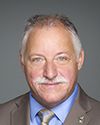Yes. We are working very closely with the Canadian Armed Forces. I believe General Misener was here presenting on some of the initiatives. My team is working hand in hand with them to add more people right on the front line—JPSUs or whatever the new terminology may be—when they're all finished the review, to help people during transition and to actually be in the trenches with our colleagues of the Canadian Armed Forces. Actually, as the result of a report from this committee, we now have authority to work, as I call it, upstream. Before, we could only start working with the veteran when they became a veteran. Now, we can actually start working with them when they're in—
There is a whole series of programs—and I won't get into those details—like military family resource centres, where we've added resources, which will help in the career transition program that people are taking now. They are all things to help and additional programs help them. We're really focusing and now, we're talking to government about these new programs. We're working hand in hand with the Canadian Armed Forces, during transition to make sure there's no duplication, that we work closely together, but that we try to address the people falling through the cracks.





